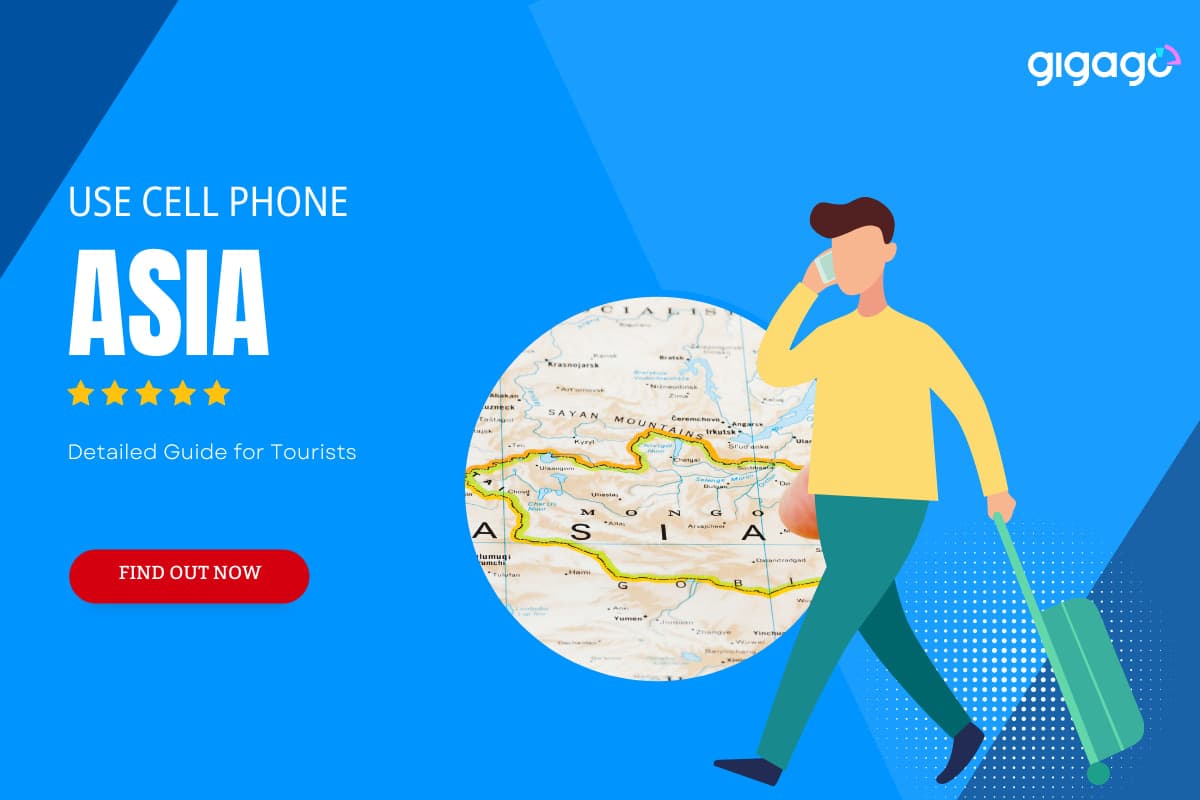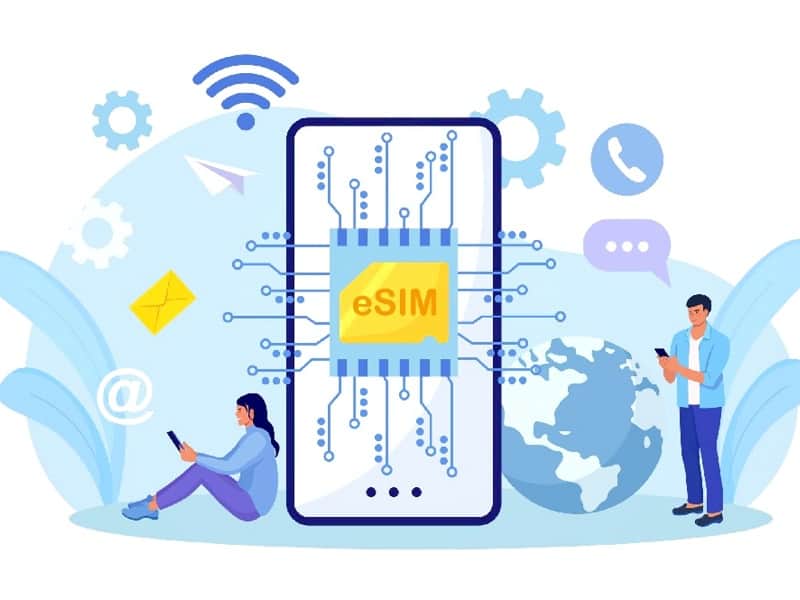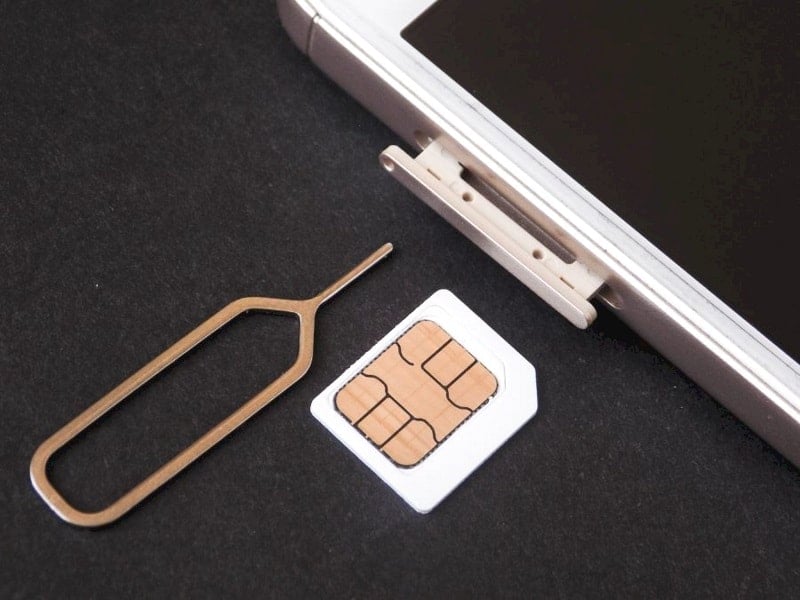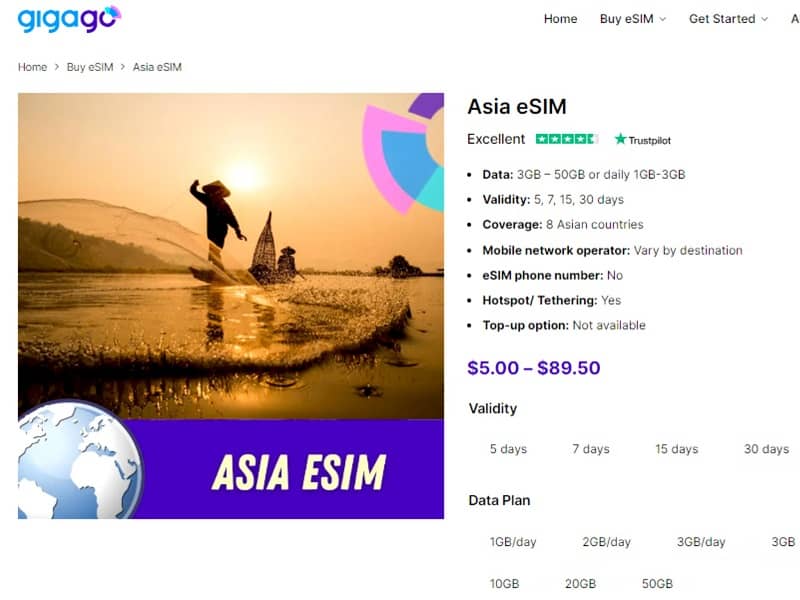It’s important when traveling Asia to know about costs and convenient purchasing locations for the best Asian SIM card, ensuring seamless connectivity.
How To Use Cell Phone In Asia 2024: Traveler’s Guide To Stay Connected
Knowing how to use cell phone in Asia is crucial to stay connected and have the best tele-communication experience while traveling to one or several Asia countries.

This article shares important information for travelers about how to use cell phone in Asia. Specifically about the options for mobile data, local SIM card, eSIM, Wifi and data roaming. Thereby equipping visitors with the knowledge to stay connected during their time in Asia through the most cost-effective means.
In this article
I. Highlights of Phone Compatibility, Frequencies and Networks in Asia
Phone compatibility: In Asia, most mobile networks utilize GSM and CDMA technology, which is broadly compatible with popular smartphone brands like Apple, Samsung, and Huawei.
- Travelers with GSM phones will generally find good compatibility across Asia.
- Some countries like Japan and South Korea used to use CDMA for their 2G and 3G networks. But, for 4G LTE and 5G, this is not an issue anymore. But, people using older CDMA-only mobile devices need to check current status of CDMA network support in the Asian country they are goin to visit, because these networks may not be operational anymore, or the coverage can be limited.
Therefore, it’s advisable to verify your phone’s specifications for compatibility.
Frequency: Depending on each country, there will be different frequency bands. But in general, Asia operates on many different frequency bands. Specifically about the LTE network, the frequencies used include B3 (1800), B7 (2600), B8 (900), B40 (2300). Besides, the network in Asia is also extremely diverse, making it easy for customers to choose.
Networks: Asia is a vast region with many countries and each has its own set of major network operators and mobile virtual network operators (MVNOs). However, it is always a good idea to check the most current information before traveling because there are always new entrants and mergers.
II. Use Cell Phone in Asia Countries – Will My Phone Work?

Yes. Typically, your phone should work when traveling to Asia.
However, to precisely determine if your cell phone work in Asia, you need to consider some factors: network compatibility, SIM unlocked status, local regulations, roaming agreements, and type of phone.
1. Network Compatibility
Know how to check your phone’s supported bands (or basically check if your phone can work abroad): usually found in the Settings or technical specifications.
Below are the network frequencies of some countries in Asia that you can refer to:
| Technology | Frequencies in Thailand | Frequencies in Japan | Frequencies in Korea | Frequencies in Singapore |
| Brand 5G | n28 (700 MHz) n41 (2500 MHz) | n3 (1800 MHz)n77 (3700 MHz) n257 (28 GHz) | n78 (3500 MHz) | n78 (3500 MHz) |
| Brand 4G | B1 (2100 MHz)B3 (1800 MHz) B8 (900 MHz) B41(2500 MHz) | B3 (1800 MHz) | B1 (2100 MHz) B3 (1800 MHz) B5 (850 MHz) B7 (2600 MHz) | B3 (1800 MHz) B7 (2600 MHz) B8 (900 MHz) |
| Brand 3G | B1 (2100 MHz) B5 (850 MHz) | N/A | B1 (2100 MHz) | B1 (2100 MHz) |
2. SIM unlock status
Having a SIM-unlocked phone is required if you want to use a local SIM card while abroad. Learn to check if your phone is unlocked.
3. International roaming
If you want to remain your primary phone number, you need to understand potential costs associated with your home carrier’s international roaming when traveling in Asia. If not, consider other alternatives.
4. Local regulations
Check if there is any restrictions on foreign phones or internet censorship issues that may affect the usability of certain services or apps.
▶ Our recommendation: For the most accurate assessment, ensure that your mobile phone is compatible with open bands. If your phone doesn’t support open bands, consider utilizing your service provider’s roaming feature. However, this option tends to be expensive and not very effective.
III. Do I Need An International Plan In Asia?
Yes. When journeying overseas, having an international plan is essential. This feature ensures continuous internet access and frequently offers additional services to improve overall convenience. Some specific benefits of having an international plan include:
- Make international calls and send texts at discounted rates.
- Access mobile data abroad at more favorable rates compared to standard data roaming charges.
- Keep your home phone number when abroad.
- You have the option to select various packages based on your requirements and the duration of your travels.

While free WiFi is available in public locations such as cafes, restaurants, and malls across every Asian country, it is important to note that using this option has many limitations . As follows:
- In certain public areas, you may be asked to complete a registration form before accessing Wi-Fi. This can potentially pose a risk of personal information exposure.
- Can’t be proactive on the Internet when needed.
- Sluggish performance caused by multiple users accessing it simultaneously.
IV. What Are Options To Use Cellphones In Asia For Tourists?
There are many convenient international plans that you can consider, such as eSIM, SIM Card and Pocket Wifi. Gigago will provide readers with comprehensive information about mobile phone usage in Asia. For detailed instructions, please refer to the instructions provided here!
1. eSIM Plan for Asia

The eSIM plan tailored for Asia presents a contemporary SIM alternative, which can be bought and activated entirely online. This feature enables travelers to utilize two SIMs concurrently, helping users maintain contact via the phone number they are using, while also connecting to the network via eSIM.
Drawbacks: Nevertheless, note that not all devices are supported with eSIM technology. Hence, it’s essential to verify in advance whether your device is compatible with eSIM functionality.
Where to buy: Travelers can choose to buy an eSIM online from either international SIM providers or local Asia SIM providers (which offer eSIM services). Alternatively, they have the option to purchase directly at airports or cities in Asia.
▶ Our recommendation: It is recommended to buy eSIMs from a reputable eSIM providers/resellers because they do not require any personal registration (unlike with local mobile network operators). We suggest Gigago eSIM because there are a variety of eSIM plans for more than 200 countries and territories in the world, including Asia, at affordable and competitive prices.
2. International SIM card for Asia

An international SIM card for Asia involves utilizing a tourist SIM from the respective country. International SIM plans can offer services for only one Asian country or several ones. There are many variations of countries and plan features for Asia.
This option is particularly economical, offering a diverse selection of packages to suit different requirements. So it is a popular choice among many tourists.
Drawbacks: The requirement to remove the primary SIM and substitute it with the international SIM heightens the risk of misplacing the main SIM during the transition.
Where to buy: Travelers can buy international SIM cards directly at airport kiosks and mobile service provider outlets.
3. Pocket WiFi

Pocket WiFi functions as a network-sharing device, utilizing a SIM card inserted within it. It is compatible with various phone models. A notable advantage of Pocket WiFi is that it doesn’t necessitate the phone to be unlocked for internet access. Furthermore, activation and usage are simple and uncomplicated.
Drawbacks: The expense of buying Pocket WiFi is comparatively high. While using it, you must consistently have it on hand and maintain a secure distance between your phone and the WiFi transmitter. Additionally, connecting too many devices to the network can impact the quality of WiFi.
Where to rent: commonly you can rent the pocket Wifi for Asia travel online (services like Rent ‘n Connect, Travelwifi, and Tep Wireless) or rent in the telecommunications kiosks or service counters at the airport in Asian countries upon arrival. alternatively, you can also rent a pocket Wifi for Asia travel through telecom companies, travel agencies, hotels, or specific rental shops (available in some countries only).
Note: When renting a pocket Wifi for Asia travel, you need to consider these factors: data limits, battery life, coverage, pickup and return option, and cost.
V. Will My Local Network Work In Asia?
Most likely possible. With your local network work, you can use cell phone in Asia. However, its drawback lies in the exorbitant roaming charges, which can be considered the most costly expense of all.
Therefore, it’s essential to limit your usage needs with this international plan. Failing to monitor data, call, or text usage may result in travelers facing unexpectedly high bills upon returning home.
VI. Gigago eSIM – An Alternative To Get Internet In Asia With Your Cell Phone
As mentioned earlier, as long as you have an eSIM-compatible device, you should use an eSIM to travel throughout Asia without having to switch out SIM cards between destinations.
Gigago eSIM stands out as the top eSIM provider for tourists to Asia.
To buy an eSIM for Asia travel, you can buy the Asia eSIM plans (that cover many Asian countries in a plan) or search for the specific countries you want to visit and buy the eSIM plans you want.

VII. Extra Tips To Use Cell Phone in Asia
To elevate your travel experience and ensure smooth and trouble-free usage of your mobile phone in Asia, put there tips into your pocket:
- Check Phone Compatibility: Ensure your phone supports Asia’s network bands.
- Activate an International Plan: Set up an international plan before your trip for internet access in Asia.
- Prioritize Security: Be cautious with public Wi-Fi, especially in places requiring registration, to protect your privacy.
- Explore eSIM Options: Consider using eSIM for a stable connection and to retain your original number.
- Stay Updated: Keep informed about mobile network updates, regulations, and available plans during your stay.
- Keep Support Contacts Handy: Save your carrier’s customer support details for quick assistance.
VIII. FAQs about How to Use Cell Phone in Asia
Q: How can I ensure internet access while traveling in Asia?
A: Consider options such as purchasing a local SIM card, activating an international plan, or using portable Wi-Fi devices.
Q: How do I check if my phone is compatible with Asian networks?
A: You can check your phone’s specifications or contact your mobile carrier to verify its compatibility with the network bands used in Asia.
Q: What should I do if I encounter connectivity issues with my phone in Asia?
A: Try restarting your phone, checking your network settings, and contacting your service provider for assistance.
IX. Conclusion
Above are shared international methods to help you easily use cell phone in Asia. Hope you have saved useful information and please visit Gigago to check out the new Asia SIM with preferential prices for your upcoming trip.
